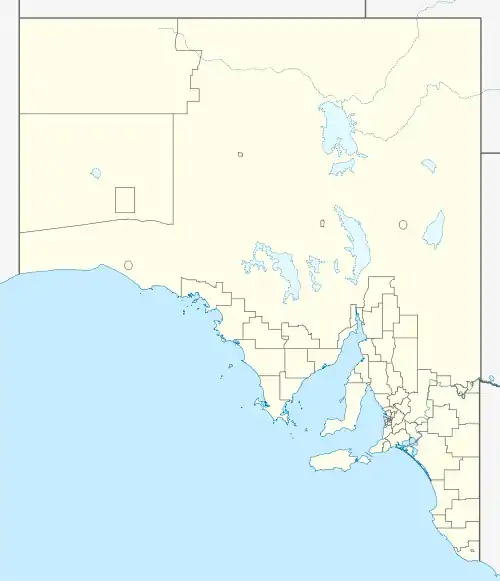Acraman crater
Acraman crater is a deeply eroded impact crater in the Gawler Ranges of South Australia.[1] Its location is marked by Lake Acraman, a circular ephemeral playa lake about 20 kilometres (12 mi) in diameter. The discovery of the crater and independent discovery of its ejecta were first reported in the journal Science in 1986.[2][3] The evidence for impact includes the presence of shatter cones and shocked quartz in shattered bedrock on islands within Lake Acraman.
 Acraman lake (circle), ringed by Lake Gairdner and others, outlining the Acraman crater depression | |
| Impact crater/structure | |
|---|---|
| Confidence | Confirmed |
| Diameter | up to 90 km (56 mi) |
| Age | ~580 Ma Late Ediacaran |
| Exposed | Yes |
| Drilled | No |
| Bolide type | Chondrite |
| Location | |
| Location | Gawler Ranges |
| Coordinates | 32°1′S 135°27′E |
| Country | Australia |
| State | South Australia |
 Location of the crater in South Australia | |
The crater is deeply eroded and its original size must be inferred by indirect means. Some authors estimate an original diameter of up to 85 to 90 kilometres (53 to 56 mi),[4] while other suggest a smaller size, perhaps only 35 to 40 kilometres (22 to 25 mi), closer to that of the depression in which Lake Acraman is centred.[5] The larger size estimate would imply an energy release of 5.2 × 106 megatons of TNT.[4]
The impact event is estimated to have occurred about 580 million years ago during the Ediacaran; this age is not derived from the crater itself but from the position of ejecta within nearby sedimentary basins.[4]
The Lake Acraman Impact Structure is listed on the South Australian Heritage Register.[6]
Ejecta layer
A widespread layer of ejecta, believed to be from the Acraman crater, is found within Ediacaran rocks of the Flinders Ranges at least 300 kilometres (190 mi) east of the crater,[3] and in drill holes from the Officer Basin to the north.[7] At the time these areas were shallow sea, and the ejecta settled into mud on the sea floor. The ejecta, containing shocked minerals and small shatter cones, is composed of rock similar in age and composition to that at the crater,[3] and is associated with an iridium anomaly suggesting contamination with extraterrestrial material.[8] An evolutionary radiation within marine microorganisms (acritarchs) occurs just above the level as the ejecta layer, and some authors believe there may be a connection.[9][10] The proximity of the crater to the type area for the Ediacara Biota is noted, though probably not significant given the likely global consequences of the impact.
John Acraman
The Acraman crater, Lake Acraman and the nearby Acraman Creek are named after South Australia Colonial businessman John Acraman.
Gallery
 Landsat image of Lake Acraman; screen capture from NASA World Wind
Landsat image of Lake Acraman; screen capture from NASA World Wind Oblique Landsat image of Lake Acraman draped over digital elevation model (10x vertical exaggeration), looking east towards the Flinders Ranges where ejecta has been found; screen capture from NASA World Wind.
Oblique Landsat image of Lake Acraman draped over digital elevation model (10x vertical exaggeration), looking east towards the Flinders Ranges where ejecta has been found; screen capture from NASA World Wind. Orange and brown soils mix with off-white saltpans, including Lake Gardiner and Lake Everard in this true-colour image.
Orange and brown soils mix with off-white saltpans, including Lake Gardiner and Lake Everard in this true-colour image.
References
- "Acraman". Earth Impact Database. Planetary and Space Science Centre University of New Brunswick Fredericton. Retrieved 2017-10-09.
- Williams, G.E. (1986). "The Acraman Impact Structure: Source of Ejecta in Late Precambrian Shales, South Australia". Science. 233 (4760): 200–3. Bibcode:1986Sci...233..200W. doi:10.1126/science.233.4760.200. PMID 17737291. S2CID 30059305.
- Gostin, V.A.; Haines, P.W.; Jenkins, R.J.F.; Compston, W.; Williams, I.S. (1986). "Impact Ejecta Horizon Within Late Precambrian Shales, Adelaide Geosyncline, South Australia". Science. 233 (4760): 198–200. Bibcode:1986Sci...233..198G. doi:10.1126/science.233.4760.198. PMID 17737290. S2CID 11307364.
- Williams, G.E.; Gostin, V.A. (2005). "Acraman-Bunyeroo impact event (Ediacaran), South Australia, and environmental consequences: twenty-five years on". Australian Journal of Earth Sciences. 52 (4–5): 607–620. Bibcode:2005AuJES..52..607W. doi:10.1080/08120090500181036. S2CID 128751351.
- Shoemaker, E.M.; Shoemaker, C.S. (1996). "The Proterozoic impact record of Australia". AGSO Journal of Australian Geology and Geophysics. 16: 379–398. Bibcode:1990LPICo.746...47S.
- "Lake Acraman Impact Structure". South Australian Heritage Register. Department of Environment, Water and Natural Resources. Retrieved 26 June 2017.
- Wallace, M.W.; Gostin, V.A.; Keays, R.R. (1989). "Geological Note: Discovery of the acraman impact ejecta blanket in the officer basin and its stratigraphic significance" (PDF). Australian Journal of Earth Sciences. 36 (4): 585–587. Bibcode:1989AuJES..36..585W. doi:10.1080/08120098908729511.
- Gostin, V.A.; Keays, R.R.; Wallace, M.W. (1989). "Iridium anomaly from the Acraman impact ejecta horizon: impacts can produce sedimentary iridium peaks". Nature. 340 (6234): 542–544. Bibcode:1989Natur.340..542G. doi:10.1038/340542a0. S2CID 4310570.
- Grey, K.; Walter, M.R.; Calver, C.R. (2003). "Neoproterozoic biotic diversification: Snowball Earth or aftermath of the Acraman impact?". Geology. 31 (5): 459–462. Bibcode:2003Geo....31..459G. doi:10.1130/0091-7613(2003)031<0459:NBDSEO>2.0.CO;2.
- Williams, George E. & Wallace, Malcolm W. (2003). "The Acraman asteroid impact, South Australia: magnitude and implications for the late Vendian environment". Journal of the Geological Society of London. 160 (4): 545–554. Bibcode:2003JGSoc.160..545W. doi:10.1144/0016-764902-142. S2CID 129728586.
External links
- Acraman at Earth Impact Database
- Satellite image of the region (from Google Maps)

